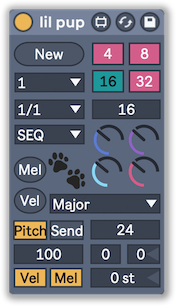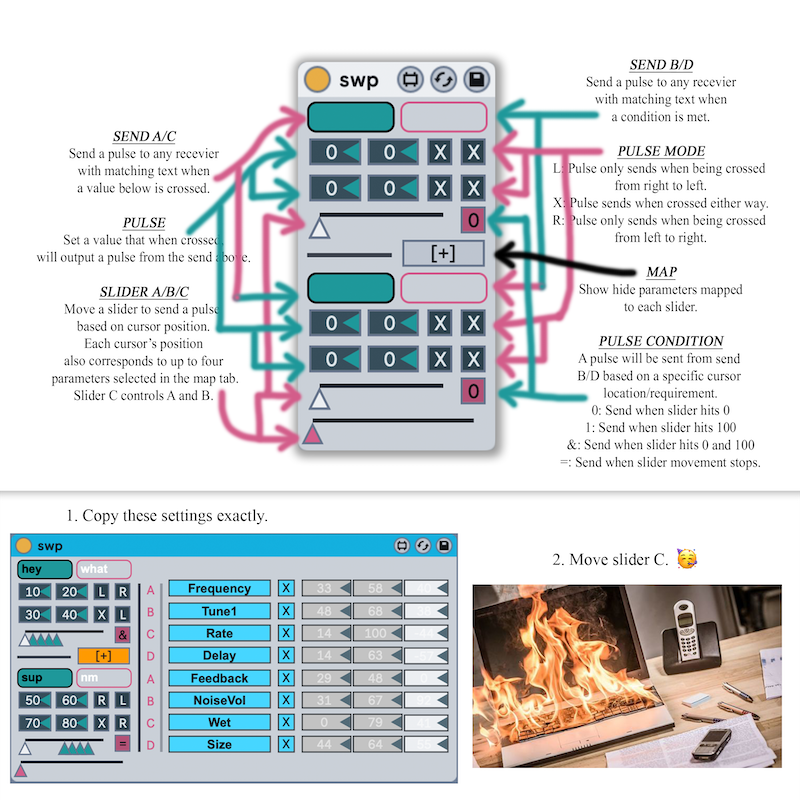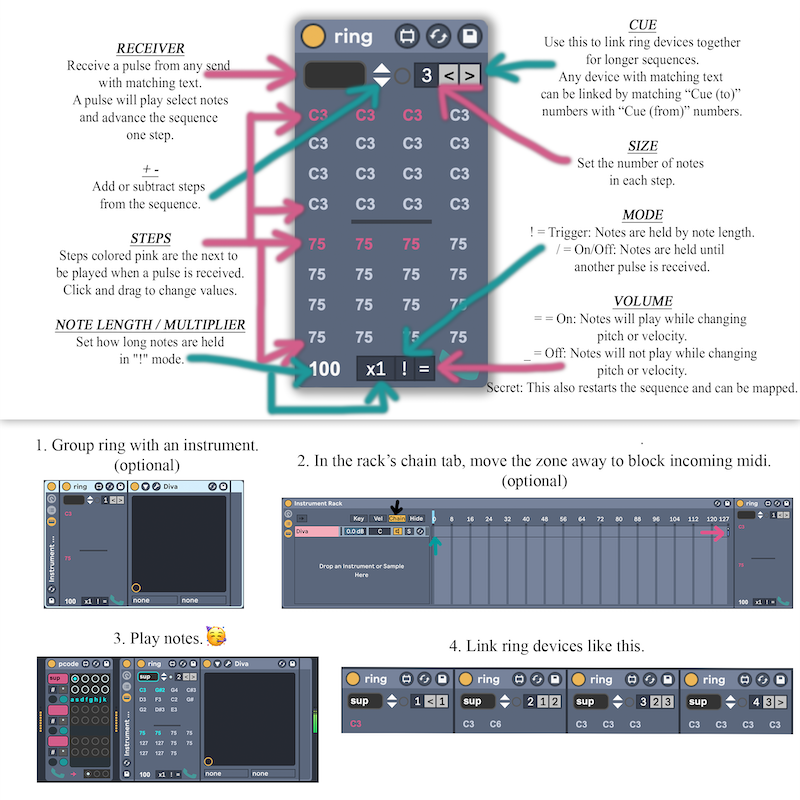An Interview with jr: Smartphones and Beyond
There's magic in using a tool someone else made to address their own artistic needs. This magic is precisely Max for Live's strength. It allows a person with an idiosyncratic idea to avoid stumbling over lower-level challenges by providing them with the structure of a DAW. This enables the developer to dig deeper into the execution of their idea and, most importantly, add personality to the resulting device.
That's why one of my favorite devices I've found on maxforlive.com this year is lil pup:

Simply put, it's a gorgeous MIDI device that randomly generates deterministic and looping sequences with dynamic timing and velocity. Here's an early exploration I made for the Cycling '74 Instagram, which was fully improvised using two instances of lil pup feeding one of Spitfire Audio's piano VSTs:
After sharing my lil pup piece on our feed, I ended up developing a friendship with its creator -- the brilliant, approachable, and endlessly motivated jr (or rj, depending on his mood). In the year since lil pup, he's developed an entire suite of devices called smartphones, which transform interaction gestures into pulses. These pulses are trafficked across the other devices through send-and-receive networks which can be used to trigger slewed envelopes, or streams of control data, or selections from MIDI note pools, etc. In short, smartphones bring modular synth-style "patch programming" to Live and the results are absolutely compelling:
I recently had the opportunity to speak with jr at length about his perspective as a designer and performer, how he got started with Max and Max for Live, and the importance of drilling down into what makes your work unique.
Filling in the blanks
jr started his journey making music with computers when he was a teenager, building tracks in Fruity Loops and making his way to Ableton Live, where he recorded guitar tracks to take back to his metal band. Eventually, his road led where many journeys with Max seem to begin -- with Autechre. "Oversteps is so pretty and I wanted to figure out how they did that!", he laughs. After reading online that Max was somehow involved, he dug into Sam Tarakajian's Delicious Max tutorials.
"I learned everything off of those videos. Just reading text to figure out what something does terrifies me. That's [also] why I love Max -- I can see what's going on."
After going through Sam's tutorials, it was clear to jr that there was still tons left to learn. Rather than get bogged down in what he didn't know, he just invested heavily in exploring the depths of ten objects.
"gswitch is the most useful. It's an if/then statement. That's really all you need. You gotta be clever. The less objects you know, the more resourceful you have to be with them. But they're just little tools, once you get good with them you know which when you need and when. Using those ten objects, I don't have to manage a whole bunch of shit in my head — a whole bunch of knowledge — so I can patch pretty quickly."
As he began building lil pup, jr knew he wanted it to create random timing. This repeating-but-non-deterministic approach led to even more interesting discoveries when he recycled that part of the patch to determine pitch.
"The idea is a hundred randoms walking through the steps, but the patch makes it loop. It's not how Autechre does it," he laughs, "but that's how I thought it should be done. I got really lucky with that, that was just how it worked. I guess it's obvious — I couldn't have done anything else, pitch would have to follow the same structure — but maybe it's not."
Action-based sequencing
While lil pup is a fully generative tool (it requires only a single MIDI note to start), jr wasn't fully satisfied with the performance paradigms that typically surround Live. This led jr to develop what he calls "action-based sequencing."
"We're sick of launching clips!" he exclaims while laughing. "There's gotta be a deeper way to perform [with Live], more interactive. Where a fader doesn't just control one thing, but four or eight things. Traditional sequencing is steps on a grid in Live. The steps make stuff happen. With action-based sequencing, you have to physically make stuff happen. Things depend on other things to happen -- nothing happens without something happening before it."
While this may sound like condition-based sequencing, many of jr's devices actually require direct input from the artist in order to kick off a flurry of notes or automate a filter sweep.
Some of the smartphones that best deliver on the rewards of this approach is the pairing of swp + rng:


In short:
swp has two individual sliders which can be controlled simultaneously by a meta-slider
rng holds pools of notes which play when a pulse is received
the artist sets up to 4 crossing points on each of swp's two sliders, which send pulses to rng when crossed
the artist can also assign up to 4 multiples of each of swp's two sliders to control other parameters in sympathy
"You can do that in Ableton with automation, but it's like that every time. Every time you press play it sounds the same. With action-based sequencing, you can plan something out, but you never get the exact same thing happening twice."
If this feels modular synth-y, that's because it sorta is -- it's patch-programming in a different context. At the heart of this kinship are the send/receive networks that make jr's smartphones entirely unique in the Max for Live space.
Invisible patch cables
Each of the smartphones feature text boxes which can direct, for example, the pulses from riding a fader over swp's crossing points. This makes the smartphones network possible, resulting from jr's hope for more opportunities for device cross-talk which reaches outside Live's left-to-right signal chain.
"Max for Live devices are modules for Live, but they should start talking to each other. If somebody makes something super simple that can talk to [across devices], it can be one 20% useful block that could make the whole system do much more. I don't want to insist that it's text boxes, but if you have an already-made device just try putting a text box on a parameter. A lot of parameters in existing devices are sick, but [it'd be better] if something else could move them, or move them in a different way."
A few developers have taken jr up on this, like Jacob Sachs-Mishalanie:
By giving jr the keys to add smartphone compatibility to spike, an otherwise standalone device gains fascinating depth as a component in a larger network of responses.
"Controlling more than one thing with a knob or a fader is really fun. Just having three things move at the same point or different points — doing that with one fader, synchronized, there's something really cool about that you wouldn't get to [otherwise]."
Networks
When you watch the devices interact with each other, it's hard to not feel an excitement bloom. There's so much playfulness inherent in the toolkit jr's built, which is personified by his performance videos on Instagram.
Toward the end of our conversation, I'm surprised to learn that I'm the first person jr's talked about Max with for any length of time. Though he engages with folks through direct messages on social media, jr's never been in a Max class or attended a meetup or even been able to talk to somebody after a show. Some of this is due to the timing of the pandemic, but it also paints a very clear picture of how access to knowledge and resources has shifted in the last few years alone. It's also a heartening confirmation that people who operate from similar and idiosyncratic perspectives can and will find each other. These connections are crucial -- they bolster exploration and new expressions.
"I was going to build [smartphones] just in Max. They wouldn't have been [Max for Live] devices, they were going to be abstractions — but I saw how many people [on Instagram] liked lil pup and I figured out how to make them into devices, which was perfect."
Who is Max for?
For a peek behind the curtain at Cycling '74, we've been spending a lot of time recently talking about how we see our users, how they see themselves, and who they see as their communities. jr is my favorite type of user. He challenges all assumptions of "who Max is for" at blazing speeds and with infectious enthusiasm.
"Do you have to be this certain type of person to do this? I don't think so, because I can fuckin' do it. My devices are complicated, but a lot of people are making devices without going to school. If you do go to school for [music tech] you learn a lot about Max, which would be ideal, but you don't have to know everything about Max to get what you want out of it. I've got 5 different devices that all do different shit from ten objects! As much as I know about Max, it's not from learning about Max. It comes from all sorts of different stuff — that's where the mindset comes from."
Besides Autechre, one of jr's inspirations is Lil B, which feels pretty aligned with his perspective that Max isn't a tool for one kind of expression or type of art.
"It's so inspiring that [Lil B] can have fun with something that's supposed to be so 'serious.' And to make as much music as he does? That was my whole goal, to make a blueprint and follow that. When you have a recipe, you can make a lot of stuff with that recipe. He's one of the first people to do that, to get a certain way of doing things and just spam it and then switch it up and do that with something else. That's what I did with smartphones — I got the thing and I spammed it."
As we wrapped up our call, I asked jr what he thinks helps make Max stick for some folks, to which he offered a brilliant prognosis:
"You have to be extremely good at problem solving. Max is building a huge puzzle that you also put together yourself and navigate. Like, building a hundred tiny little puzzles you have to solve where everything's smaller pieces of a bigger piece. Objects turn into patches, patches turn into devices, devices turn into music."
Boosting the signal
If you can't wait to start playing with these devices, jr has a number of lite versions available for free on maxforlive.com, with full versions between $10-$25 available on his website.
To learn your way around, I highly recommend watching jr's recent livestream, where he demonstrates how to structure a Live Set around smartphones:
And if you want to get your own devices onto the smartphones network, scroll down to grab example devices for both send and receive. Connect a pulse from your own devices to send to any smartphones receiver with the same name, or replace any bangs or clock signals with pulses from smartphone transmitters.
Happy cross-patching!
by dan derks on October 13, 2020

